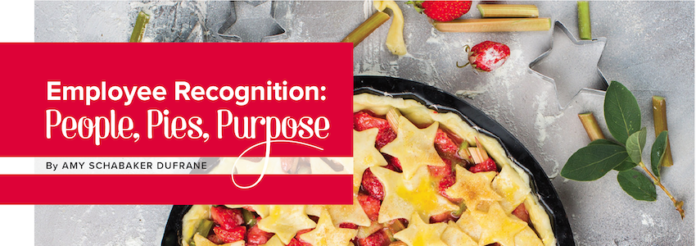By Amy Schabaker Dufrane
Employee recognition – which according to experts, started in North America about 70 years ago – has taken many forms since then. Perhaps the most widely known and historically tied to the length of service is the ceremonial gold watch. Leading up to this prized form of gratitude, employees would receive lapel pins celebrating one, five, ten or more years of service. As new generations entered the workforce, jewelry was replaced by awards catalogs filled with merchandise that corresponded to different levels of recognition. It is no surprise that as the speed of business accelerated, technology played a role in employee recognition. Ranging from “wow” tweets on social media to virtual badges indicating performance accomplishments, recognition is no longer a lengthy journey to a single moment.
Regardless of how employee recognition is expressed – whether with a Lucite award or swag box – the underlying science remains the same. A recent study of more than 12,000 employees across 12 countries by Gallup and Workhuman found that when employees are recognized at work, they are up to 10 times as likely to strongly agree that they belong at their organization. In contrast, employees who lack a strong sense of belonging are up to 12 times as likely to be disengaged and five times more likely to be looking for another job. Equally compelling from the findings is that high-quality recognition is strongly associated with lower rates of burnout.
So, by now, you’re probably already wondering how pies relate to employee recognition. One of our HRCI board members is Katharine “Kathy” Claytor. A celebrated HR thought leader, we gain tremendous insights from her experience as a CHRO and global business expert. When I was preparing to cover the employee recognition topic for this article, I asked her for her guidance.
“Recognition is an opportunity to make an individual connection with each member of your team, and who wouldn’t want to do that? There is a saying that goes, ‘At the end of the day, your teams may not remember what you said or did; they will remember how you made them feel,’” she said. “With gratitude and just before Thanksgiving, we send each team member a homemade apple pie to their homes. The feedback is about how we made them feel; grateful, happy, reminiscent.”
Her response gave me pause. Of course, it also elicited all the senses that go along with a homemade apple pie (or pumpkin or cherry, your pick). Feeling valued, involved and satisfied.
Delving into the Gallup and Workhuman study, their research found that employees who strongly agree that recognition is an integral part of their culture are up to 91 percent more likely to be thriving in their lives, and those who have high-quality recognition experiences are up to 10 times as likely to agree they that they belong.
“Belonging is a key component of inclusion. When employees are truly included, they perceive that the organization cares for them as individuals — their authentic selves. HR helps make that happen,” said Ania Krasniewska, Group Vice President at Gartner. “It’s good for employees — and ultimately improves business performance.” Gartner advises organizations to strive for a workplace culture in which individuality is both noticed and valued.
Claytor concurs and offers tips on how all of us can advance employee recognition – regardless of our workplace environment. She believes that recognition has become increasingly important in light of today’s hybrid and decentralized settings and recommends taking a layered approach that accounts for all types of moments rather than simply marking one’s annual service to the organization.
Claytor says, “Recognition is a means to stay connected up, down, and across your organization. Done well, recognition is authentic, personal, and, when possible, customized. It can be company swag, but it can also be a handwritten note or conversation for a life event. It can be a note of thanks for business results or an invitation to a charitable or volunteerism event that aligns with your company’s mission, or a personalized experience. The cadence can matter, especially if you’re only reading through the annual list of service awards once a year. Remember, it’s how you make people feel.”

